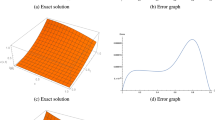Abstract
This article presents a uniformly convergent numerical technique for a time-dependent reaction-dominated singularly perturbed system, including the same diffusion parameters multiplied with second-order spatial derivatives in all equations. Boundary layers are observed in the solution components for the small parameter. The proposed numerical technique consists of the Crank–Nicolson scheme in the temporal direction over a uniform mesh and quadratic \(\mathbb {B}\)-splines collocation technique over an exponentially graded mesh in the spatial direction. We derived the robust error estimates to establish the optimal order of convergence. Numerical investigations confirm the theoretical determinations and the proposed method’s efficiency and accuracy.





Similar content being viewed by others
References
N.S. Bakhvalov, On the optimization of methods for solving boundary value problems in the presence of boundary layers. Zh. Vychisl. Mat. Mat. Fiz. 9, 841–859 (1969)
G.I. Barenblatt, I.P. Zheltov, I.N. Kochina, Basic concepts in the theory of seepage of homogeneous liquids in fissured rocks. J. Appl. Math. Mech. 24, 1286–1303 (1960)
C. Clavero, J.L. Gracia, J.C. Jorge, High-order numerical methods for one-dimensional parabolic singularly perturbed problems with regular layers. Numer. Methods Partial Differ. Equ. 21, 149–169 (2005)
C. Clavero, J.L. Gracia, F. Lisbona, Second order uniform approximations for the solution of time dependent singularly perturbed reaction-diffusion systems. Int. J. Numer. Anal. Model. 7, 428–443 (2010)
P. Constantinou, C. Xenophontos, Finite element analysis of an exponentially graded mesh for singularly perturbed problems. Comput. Methods Appl. Math. 15, 135–143 (2015)
S.C. Cowin, Bone poroelasiticity. J. Biomech. 32, 217–238 (1999)
P. Das, S. Natesan, A uniformly convergent hybrid scheme for singularly perturbed system of reaction-diffusion Robin type boundary-value problems. J. Appl. Math. Comput. 41, 447–471 (2013)
P. Das, J. Vigo-Aguiar, Parameter uniform optimal order numerical approximation of a class of singularly perturbed system of reaction diffusion problems involving a small perturbation parameter. J. Comput. Appl. Math. 354, 533–544 (2019)
R. Dillon, P.K. Maini, H.G. Othmer, Pattern formation in generalized Turing systems. J. Math. Biol. 32, 345–393 (1994)
E.P. Doolan, J.J.H. Miller, W.H.A. Schilders, Uniform Numerical Methods for Problems with Initial and Boundary Layers (Boole Press, Dublin, 1980)
P.A. Farrell, A.F. Hegarty, J.J.H. Miller, E. O’Riordan, G.I. Shishkin, Robust Computational Techniques for Boundary Layers (Chapman & Hall/CRC, Boca Raton, 2000)
A.C. Fowler, Convective diffusion of an enzyme reaction. SIAM J. Appl. Math. 33, 289–297 (1977)
J.L. Gracia, F.J. Lisbona, A uniformly convergent scheme for a system of reaction-diffusion equations. J. Comput. Appl. Math. 206, 1–16 (2007)
W.J. Kammerer, G.W. Reddien, R.S. Varga, Quadratic interpolatory splines. Numer. Math. 22, 241–259 (1974)
N. Kopteva, Maximum norm a posteriori error estimates for a 1D singularly perturbed semilinear reaction diffusion problem. IMA J. Numer. Anal. 27, 576–592 (2007)
S. Kumar, S.C.S. Rao, A robust overlapping Schwarz domain decomposition algorithm for time-dependent singularly perturbed reaction-diffusion problems. J. Comput. Appl. Math. 261, 127–138 (2014)
D. Kumar, A uniformly convergent scheme for two-parameter problems having layer behaviour. Int. J. Comput. Math. 99, 553–574 (2022)
T. Linß, N. Madden, Accurate solution of a system of coupled singularly perturbed reaction-diffusion equations. Computing 73, 121–133 (2004)
T. Linß, N. Madden, Layer-adapted meshes for a linear system of coupled singularly perturbed reaction-diffusion problems. IMA J. Numer. Anal. 29, 109–125 (2009)
T. Linß, G. Radojev, H. Zarin, Approximation of singularly perturbed reaction-diffusion problems by quadratic \(C^1\)-splines. Numer. Algorithms 61, 35–55 (2012)
N. Madden, M. Stynes, A uniformly convergent numerical method for a coupled system of singularly perturbed linear reaction-diffusion problems. IMA J. Numer. Anal. 23, 627–644 (2003)
M.J. Marsden, Quadratic spline interpolation. Bull. Am. Math. Soc. 80, 903–906 (1974)
H.G. Roos, M. Stynes, L. Tobiska, Robust Numerical Methods for Singularly Perturbed Differential Equations: Convection-Diffusion-Reaction and Flow Problems (Springer, Berlin, 2008)
D. Shakti, J. Mohapatra, P. Das, J. Vigo-Aguiar, A moving mesh refinement based optimal accurate uniformly convergent computational method for a parabolic system of boundary layer originated reaction-diffusion problems with arbitrary small diffusion terms. J. Comput. Appl. Math. 404, 113167 (2022)
L. Shishkina, G. Shishkin, Robust numerical method for a system of singularly perturbed parabolic reaction-diffusion equations on a rectangle. Math. Model. Anal. 13, 251–261 (2008)
G. Singh, S. Natesan, A uniformly convergent numerical scheme for a coupled system of singularly perturbed reaction-diffusion equations. Numer. Funct. Anal. Optim. 41, 1172–1189 (2020)
S. Singh, D. Kumar, H. Ramos, A uniformly convergent quadratic \(B\)-spline based scheme for singularly perturbed degenerate parabolic problems. Math. Comput. Simul. 195, 88–106 (2022)
R. Vulanović, L. Teofanov, A uniform numerical method for semilinear reaction-diffusion problems with a boundary turning point. Numer. Algorithms 54, 431–444 (2009)
Acknowledgements
The authors are grateful to the unknown reviewers for their insightful observations leading to the improvement of the manuscript. The first author is thankful to UGC, New Delhi, India, for providing the senior research fellowship (award letter No. 1078/(CSIR-UGC NET JUNE 2019)).
Author information
Authors and Affiliations
Corresponding author
Additional information
Publisher's Note
Springer Nature remains neutral with regard to jurisdictional claims in published maps and institutional affiliations.
Rights and permissions
Springer Nature or its licensor (e.g. a society or other partner) holds exclusive rights to this article under a publishing agreement with the author(s) or other rightsholder(s); author self-archiving of the accepted manuscript version of this article is solely governed by the terms of such publishing agreement and applicable law.
About this article
Cite this article
Singh, S., Kumar, D. & Vigo-Aguiar, J. A robust numerical technique for weakly coupled system of parabolic singularly perturbed reaction–diffusion equations. J Math Chem 61, 1313–1350 (2023). https://doi.org/10.1007/s10910-023-01464-w
Received:
Accepted:
Published:
Issue Date:
DOI: https://doi.org/10.1007/s10910-023-01464-w
Keywords
- Singularly perturbed problem
- Weakly coupled system of PDEs
- Boundary layer
- Parameter-uniform convergence
- Exponentially graded mesh




